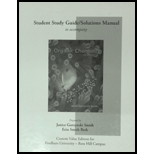
Concept explainers
(a)
Interpretation: The curved arrows are to be drawn to show the conversion of A into B in Step [1].
Concept introduction: Curved arrows aid in determining the movement and flow of electrons in the reaction. The electrons that take part in the
Half headed arrows are used to show the flow of single electrons, while the full headed arrow shows the movement of electron pairs.
(b)
Interpretation: The compound X is to be identified by using the curved arrows drawn for step [2].
Concept introduction: Curved arrows aid in determining the movement and flow of electrons in the reaction. The electrons that take part in the chemical reactions are shown by the curved arrows. An electronegative element in the reaction attracts electron toward it.
Half headed arrows are used to show the flow of single electrons, while the full headed arrow shows the movement of electron pairs.
Want to see the full answer?
Check out a sample textbook solution
Chapter 6 Solutions
Organic Chemistry -Study Guide / Solution Manual (Custom)
 Organic Chemistry: A Guided InquiryChemistryISBN:9780618974122Author:Andrei StraumanisPublisher:Cengage Learning
Organic Chemistry: A Guided InquiryChemistryISBN:9780618974122Author:Andrei StraumanisPublisher:Cengage Learning
